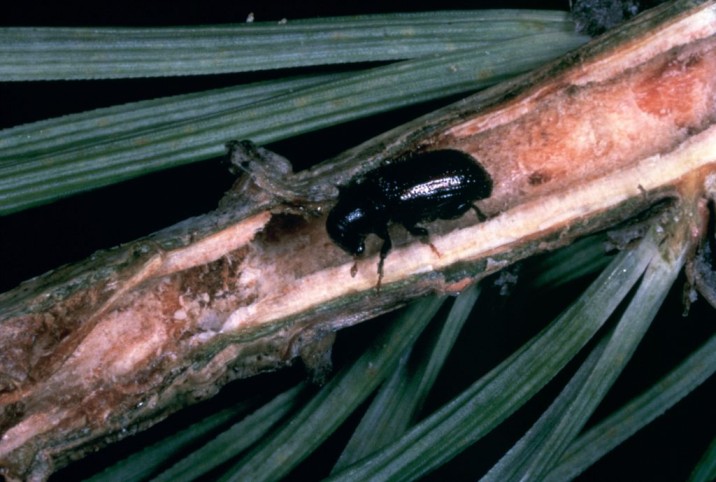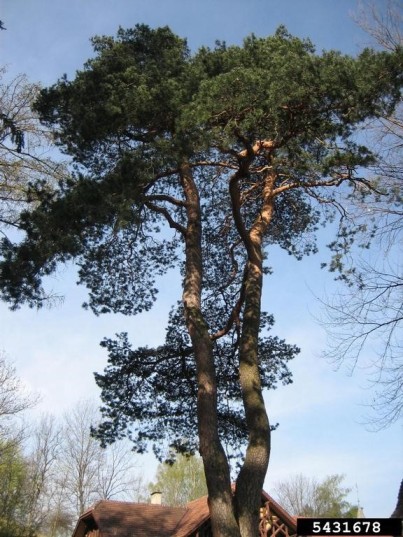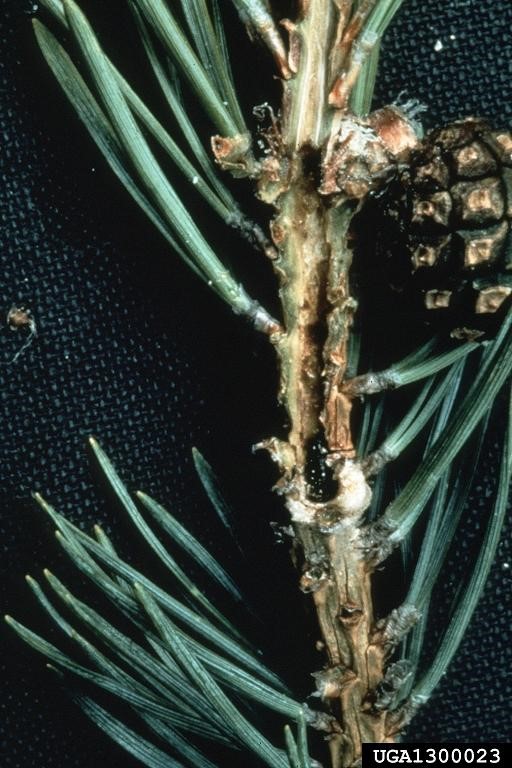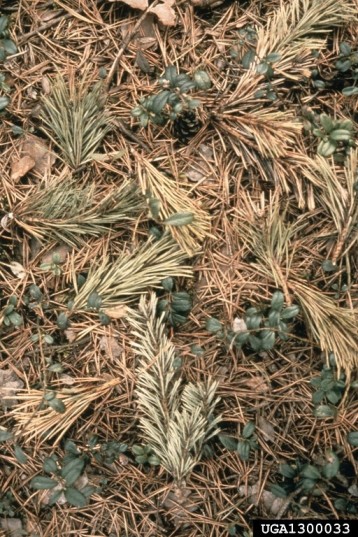Pine Shoot Beetle (Tomicus piniperda)
French common name: Grand hylésine des pins

Order: Coleoptera
Family: Buprestidae
The pine shoot beetle (Tomicus piniperda L.; PSB) is native to Europe, North Africa and Asia. It is believed that it was first introduced to North America on ships transporting lumber from Europe, and was first detected in 1992 in the state of Ohio. PSB is now found throughout north central and northeastern United States, and is considered established in portions of Ontario, Quebec and New Brunswick (mostly where Scots pine is present).
Most damage caused by this species has been reported in areas where pine plantations exist, especially in instances of poorly managed plantations. The PSB mainly targets weak pine trees, but can also attack healthy ones when its populations are abundant. The damage to pine can have significant economic impacts on the saw log and pulpwood industries. In response to the threat of PSB, regulated areas have been established in regions of Ontario and Quebec.
Physical Description
Egg: Pearly white in colour, smooth, oblong in shape, and approximately 1mm in length.
Larvae: Up to 5mm long, legless, and are white in colour with brown heads.
Pupae: Larvae pupate at the end of the feeding galleries (pictured right) under the bark, and emerge as young adults in the summer months.
Adults: Small (3-5 mm), cylindrical and black in colour.
Life Cycle
The PSB completes its life cycle, from egg to adult, in three months. The female adult PSB bores up to 25 cm tunnels between the inner bark and the outer sapwood, (referred to as maternal galleries) where it lays its eggs and then dies. After hatching, the emerging larvae tunnel away from the maternal galleries and feed on the cambium tissues (living tissues that are responsible for increasing the diameter of the stem) for approximately 6-8 weeks which increases the susceptibility of infested trees to fungal penetration.
PSB can attack pine trees in two ways:
1. Larval feeding on the cambium tissue, resulting in the death of the tree by girdling (disrupting the living connection between the roots and leaves).
2. Maturation feeding by adult PSBs on the shoots of the host tree.
The adult beetles can mine up to 10 cm of each attacked shoot and can attack up to 6 shoots in their lifetime, stunting the growth of the tree. Adult PSB feeding activities are thought to be the most damaging to host trees.
The primary host for the PSB in its native range is the Scots pine (Pinus sylvesris). In North America, all pine tree species are susceptible to the PSB, including jack pine (Pinus banksiana), red pine (Pinus resinosa), eastern white pine (Pinus strobus), and the Scots pine (Pinus sylvesris), commonly found in eastern Canada. When the PSB is abundant, it can also threaten the balsam fir (Abies balsamea), the Norway spruce (Picea abies) and larch (Larix laricina).

Scots Pine
Photo: Luana Vargas, Desert Botanical Garden, Bugwood.org
Signs and symptoms of PSB include:
- Resin secretion at points of entry
- Brownish frass (larval excrement) on the surface of the tree
- Larval galleries underneath the bark in dying pine trees
- Holes, 2 mm in diameter, in the outer bark created as new adults exit
- Round holes on the shoots of attacked trees due to the feeding activity of mature beetles resulting in an impairment of photosynthesis
- Reddish-yellow shoots
- Dead shoots may be found on the ground around the site of infested trees
- Most of the damage caused by the PSB has been reported in areas where pine plantations exist. The PSB mainly targets weak pine trees, but can also attack healthy ones when its populations are abundant (Morgan et al., 2004).
The impacts of infestations may be heightened by the various blue-staining fungi that are often vectored (carried) by the beetle in Ontario (Hausner et al., 2005) and the U.S. (Jacobs et al., 2004).

Adult PBS shoot gallery
Photo: E. Richard Hoebeke, Cornell University, Bugwood.org

Pine terminals, infested by adult pine shoot beetle, that have fallen from a host tree
Photo: E. Richard Hoebeke, Cornell University, Bugwood.org
The PSB is found in Canada (parts of Quebec, Ontario and New Brunswick), north central and northeastern United States (Connecticut, Illinois, Indiana, Iowa, Maine, Maryland, Massachusetts, Michigan, Minnesota, Missouri, New Hampshire, New Jersey, New York, Ohio, Pennsylvania, Rhode Island, Virginia, Vermont, West Virginia, and Wisconsin).
Economic impacts
Damage to pine trees can affect many industries in Canada, including Christmas tree farms, saw log, and pulpwood industries. The PSB and associated fungi can cause the quality of timber to deteriorate, resulting in negative implications for industries relying on high quality wood.
Quarantines to restrict the movement of host material for the PSB have been implemented in an effort to minimize the long-term risk of these economic impacts. However, quarantines can result in increased immediate costs to industry associated with treatments, certification, reduced shipping volumes or rejected shipments (USDA/APHIS, 2006).
Ecological impacts
Heavy PSB infestations can cause severe damage to pine shoots, as a single adult beetle can destroy up to six branches during its maturation period. Coupled with larval feeding, and pathogenic fungi introduction, the PSB can be lethal to pine populations.
Tree damage and mortality may disrupt the ecosystem and food chain, impacting native plants and animals depending on the severity and density of the attack (The Main Invasion, n.d.)
Social impacts
Many species of pine trees are commonly planted or occur naturally in Canada’s forests and urban areas, adding value to parks, neighbourhoods, campgrounds, and properties. PSB attacks can result in the decline of tree health affecting property values due to the alteration of woodland aesthetics, and potentially costing landowners large amounts to remove the dead or hazardous trees. PSB attacks can also result in the reduction of wildlife and tree species diversity on private and public forest lands.
Effective on November 4, 2020, the Canadian Food Inspection Agency has made the determination to deregulate the Pine Shoot Beetle. Twenty years after this pest`s establishment in Canada, it has been determined that there is little evidence that it will cause significant harm to native pine stands.
You can read more about the CFIA’s determination to deregulate here.
Respond and Control
Mechanical
Mechanical control is considered one of the most effective control methods for the PSB. Potential egg-laying materials (such as stressed, dying, or dead pine trees) should be removed from a high-risk forest before the emergence of beetles in the spring (ISSG, n.d). This reduces the PSB population by suppressing the emergence of new beetle generations. The mechanical sanitation process includes:
- Felling weak and susceptible pine trees,
- Chipping and burning discarded suitable breeding material
Note: Consider using trap logs for luring the PSB to breed within, then destroy the material by chipping or burning before adults emerge.
Biological
In southern Ontario and Quebec, the PSB is considered a secondary bark beetle as it mainly colonizes dead trees, or trees with poor vigour (Morgan et al., 2004). The U.S. studied the potential of the European red-bellied clerid (Thanasimus formicarius) as a biological control, however, the research was not pursued due to concern over potential impacts on native insect species (ISSG, n.d). Research is ongoing to determine if any suitable biological control agents exist.
Chemical
Some insecticides, such as lambda-cyhalothrin, are used in the U.S. in efforts to suppress the PSB and are also registered for use in Canada. At the current time, Permethrin is registered for use on Christmas tree plantations in Canada. Poland et al. (2004) showed that a blend of 1-hexanol, (Z)-3-hexen-1-ol, (E)-2-hexen-1-ol, 3-octanol and verbenone can be used as an effective repellent to the PSB.
Insecticides are applied to different parts of infested trees to serve as targeted treatments. Insecticides can also be applied to the stumps to target larval development between April and May, or they can be applied on foliage right before the emergence of the adult beetles during the month of June. Insecticides should be used with caution and in compliance with the label.
Be sure to consult your provincial authorities as different provinces may have alternate regulations for the use of some pesticides, and registration status is subject to change.
